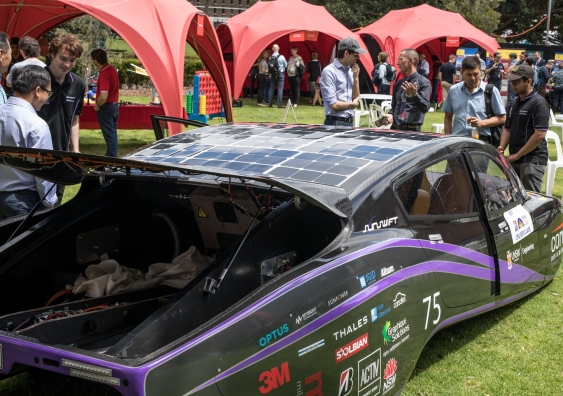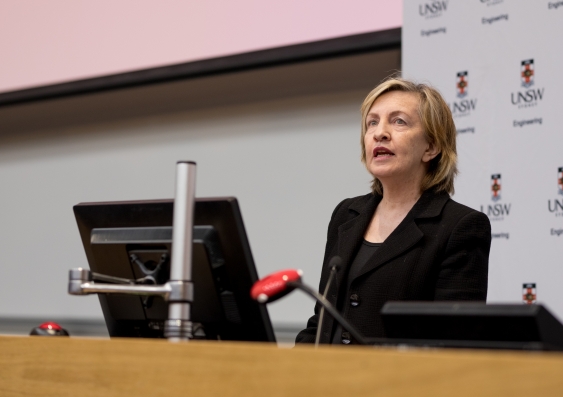Inaugural Engineering Faculty Showcase delivers a vision for the future
UNSW Engineering's Faculty Showcase provided an impressive insight into the many research achievements and student-led project outcomes across the nine schools.
UNSW Engineering's Faculty Showcase provided an impressive insight into the many research achievements and student-led project outcomes across the nine schools.

UNSW Engineering staged its first Faculty Showcase on Monday, providing an impressive insight into the many research achievements and student-led project outcomes across the nine schools.
Dean Professor Mark Hoffman opened the day by welcoming guests at a stand-up breakfast in the clouds on the solar rooftop of the Tyree Building, Kensington campus, and discussed the importance of the solar projects being undertaken at UNSW.
“Solar energy is advancing rapidly and, due to the decreasing cost, we are finding that the investment in the generation of solar farms is now a more cost-effective option than new gas-fired or new coal-fired energy,” he said.
“UNSW Engineering is working at the forefront of solar energy and aiming to make a significant impact in this evolving market.”
Hoffman said UNSW Engineering was the largest and most successful engineering faculty in Australia, with 15,500 students (33% international and 24% female) and ranked in the top 50 in the world.
“Our ambition is to raise the recognised quality of fundamental applied research to new levels and achieve significantly greater impact and translation of our research while transforming the way we collaborate with commercial partners,” he said.
“We aim to create unique, innovative and entrepreneurial graduates who are globally-focussed leaders and recruit and develop outstanding staff and students with a focus on creating gender equality, especially at senior academic levels.”
UNSW President and Vice-Chancellor Professor Ian Jacobs addressed the Engineering Faculty Town Hall and acknowledged the Faculty's many achievements and the importance of the ‘People, people, people’ mantra.
“Whether it is the ground-breaking research in energy, in water, in biomedicine, in health, in civil engineering, in data, or in cyber security – all of that is about great people working together,” he said.
“It has been a magnificent year for engineering and we expect much more. Keep inspiring students and staff and do what engineering is all about: having an impact on people in Australia and around the world. Thank you for a great year’s work.”

Professor Mary O'Kane delivers the inaugural Ada Lovelace Oration. Photo: UNSW Engineering
Following some of the formal proceedings, the faculty held a Showcase festival of student-led activity displays. These included the Redback Racing team, who design, construct and race an open-wheeled race car, the BLUEsat Group,a collection of undergraduate students dedicated to creating easy-to-access space technology, and CREATE, one of the largest student-led engineering and design organisations at UNSW, who showcased their unmanned aerial vehicle which is being entered into the Land O’Lakes Drone Challenge in Minnesota.
Also on display was the solar car of the UNSW solar racing team Sunswift. The UNSW solar racing team designs and builds solar-powered cars to race in the biennial World Solar Challenge, a 3,000km race from Darwin to Adelaide. Unfortunately, the team had to pull out of this year's race due to rear suspension failure. The Sunswift team is entirely student run and holds the world land-speed record for an electric vehicle.
The Engineering showcase concluded with Professor Many O’Kane AC delivering the inaugural Ada Lovelace Oration at UNSW, reminding the audience that the key to solving the country’s productivity conundrum is rapid technical innovation which is typically the domain of engineers working in diverse teams.
“Engineering is the obvious profession to contribute most to lifting Australia’s productivity growth,” the state’s Chief Scientist & Engineer said.
But she added that Australia must first overcome what had been a “classic case of market failure” in the engineering profession.
“There are many things we need to do but above all we need to produce a large number of engineers who are confident entrepreneurs,” Professor O’Kane said.
“This needs to be complemented by a packet of other measures – including ensuring all kids are confident in maths; engineering is an attractive option for our young people – female and male; and the number of women in engineering courses at least doubles, and women feel that staying the profession is rewarding."